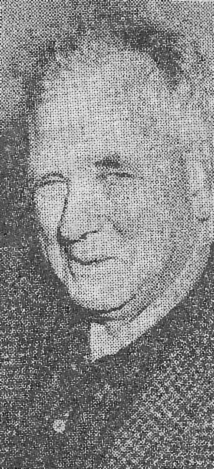Scarlett Ron
Ronald (Ron) Jack Scarlett 1911 - 2002

Ron was born in Stoke, Nelson to a large impecunious family. His father was a sawmiller and moved frequently to get work. As a consequence Ron attended many primary schools. He had a natural curiosity and as a boy collected fossil shells and bones and was a voracious reader, which was a lifelong passion.
He left school at 14 and worked variously as a labourer, coal miner, green keeper, gardener, truck driver and gold miner.
He commenced a BA at Canterbury in 1938 as an adult entry student. It was not completed until after the war. He also took Skinner’s anthropology course at Otago University in 1949.
Christian peace activisim at the start of the war lead to conscientious objection. Despite being prepared to serve in an ambulance unit he was interned at Mount Crawford Prison and later Hautu Camp near Turangi in the North Island, employed on scrub cutting. This was a camp for people regarded as the most recalcitrant. His left wing orientation was set in these times. There are many references to him in A C Barrington's prison diary[1] including accounts of his co-operation with others to sustain his vegetarian diet. Ron would occasionally talk about the experience and the resistance the inmates would put up when the conditions and treatment became oppressive.
In 1950 he joined Canterbury Museum as a recorder of collections, later moving to be the Research Associate in Osteology. In this role he worked on the collections of the Museum, collected new material, and assisted archaeologists with bird and other animal identifications.
Ron was a founder member of the New Zealand Archaeological Association and the founder editor of the New Zealand Archaeological Association Newsletter (now Archaeology in New Zealand), editing the first four volumes.
Consistent with his vigorous early life Ron was a committed field researcher undertaking work at paleontological and archaeological sites, the latter usually in collaboration with others. Pyramid Valley (1949 and later, with Duff) and Lake Poukawa stand out for bird bones.
His contribution to campfires at digs was usually the song ‘Down in the Canebrake’ aka ‘Nancy Till’.
Down in the canebrake close by the mill,
There liv'd a yellow girl, her name was Nancy Till;
She knew that I lov'd her, she knew it long,
I'm going to serenade her and I'll sing this song.
CHORUS
Come, love, come, the boat lies low,
She lies high and dry on the Ohio;
Come, love, come, won't you go along with me?
I'll take you down to Tennessee.
- and occasionally:
The people’s flag is palest pink,
Its not as red as you might think.
He was a vegetarian and lifelong bachelor.
After retirement in 1981 he continued to work at the Museum on a voluntary basis as Emeritus Curator of Osteology and published some articles on naval history. He wrote two pieces of memorabilia for the NZAA Newsletter (Scarlett 1982, 1986).
He was awarded the MBE in 1996 for services to science. The affection with which he was held by archaeologists is reflected in the long list of references to him in Digging Into History (2004, Archaeology in New Zealand special issue 47(4)).
Ron is quoted on the Climate Change page of this site.
Festschrift: Birds of a Feather. Osteological and Archaeological Papers from the South Pacific in Honour of R J Scarlett. 1979 Ed. A Anderson, New Zealand Archaeological Association Monograph 11, BAR International Series No 62.
2002 Archaeology in New Zealand 45(3):176-178 and 45(4):274-276.
The Christchurch Press 27 July 2002.
Bibliography
This covers archaeological papers only.
1958 A Dentalium Shell Necklace Workshop. Journal of the Polynesian Society 67(1):75.
1960a Excavations at Waitara. New Zealand Archaeological Association Newsletter 3(2):4-7.
1960b Excavations at Pari Whakatau, Claverley. New Zealand Archaeological Association Newsletter 4(l):2-7.
1961 Conference report 1960. New Zealand Archaeological Association Newsletter 3(3):3-ll.
1962 Interim List of Moa Species from North Island Archaeological Sites. New Zealand Archaeological Association Newsletter 5(4):245-246.
1963 Comments on Excavations at South Bay. New Zealand Archaeological Association Newsletter 6(3):159-160
1967 Adzes and Chisels from the Heaphy River. Records of the Canterbury Museum 8(3):213-234.
1972 Bones for the New Zealand Archaeologist. Canterbury Museum Bulletin 4.
1974 Moa and Man in New Zealand. Notornis 21(1):1-12. Paper on line.
1977 Whakaepa: investigations of site S74/9. New Zealand Archaeological Association Newsletter 20(1):25-27.
1979a Avifauna and Man. pp 75-90 in Anderson, A Ed. 1979 Birds of a Feather: Osteological and archaeological papers from the South Pacific in honour of R J Scarlett. British Archaeological Reports, International Series 62, Oxford.
1979b Roger Shepherd Duff: an appreciation and tribute. New Zealand Archaeological Association Newsletter 22(2):47.
1982 Archaeology on a shoe-string: excavations at Heaphy River mouth 1961-1963. New Zealand Archaeological Association Newsletter 25(3):180-182.
1986 Sarah's Gully and elsewhere. New Zealand Archaeological Association Newsletter 29(4):210-223.
Wilkes, O R and R J Scarlett
1964 Further Heaphy River excavations. New Zealand Archaeological Association Newsletter 7(3):118-132.
1967 Excavation of a moa-hunter site at the mouth of the Heaphy River. Records of the Canterbury Museum VIII (3): 177–208.
Wilkes, O R, R J Scarlett and George Boraman
1963 Two moa-hunter sites in north-west Nelson. New Zealand Archaeological Association Newsletter 6(2):88-93.
References
- ↑ Pratt, J., 2016, The Prison Diary of A. C. Barrington. Dissent and conformity in wartime New Zealand. Otago University Press Dunedin.

